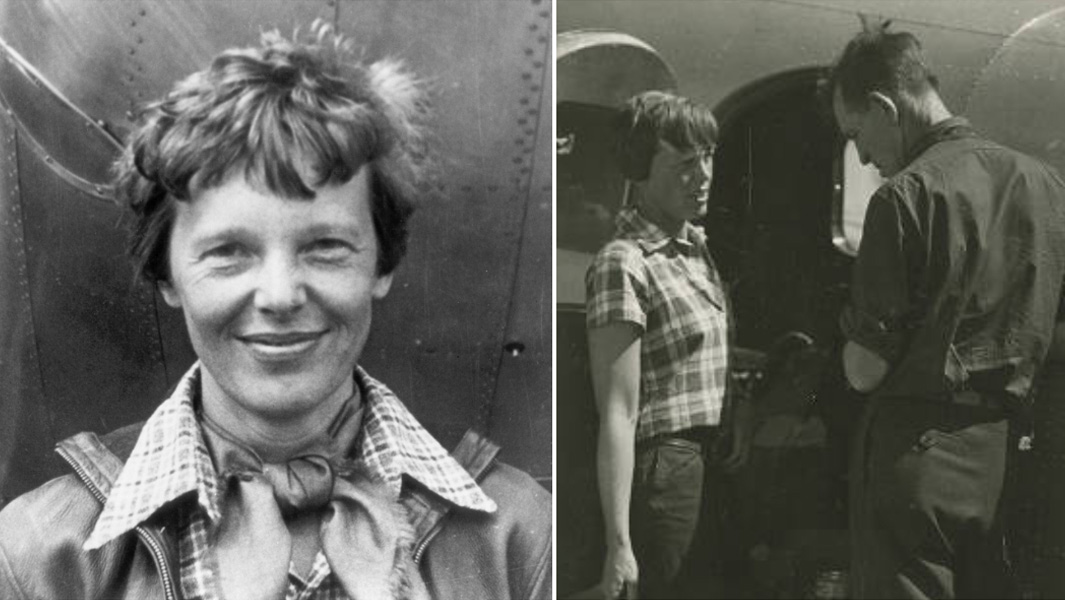The mysterious disappearance of record-breaking pilot Amelia Earhart

Pioneering aviator Amelia Earhart became the world’s first female to fly solo across the Atlantic in May 1932, aged 34, after piloting a single-engine Lockheed Vega from Canada to Northern Ireland in 13 hours 30 minutes.
She also holds a record for completing the first flight from Hawaii to North America, covering the 3,862-km (2,400-mi) distance between Honolulu and California in 18 hours on 11 January 1935.
Two years later, in 1937, she attempted to circumnavigate the globe, however, after completing 35,400 km (22,000 mi) of her journey, her plane vanished somewhere between Papua New Guinea and Howland Island in the Pacific Ocean. Amelia Earhart was never seen again.

Earhart’s journey began in Oakland, California, with her navigator Fred Noonan on board the twin-engine Lockheed Electra 10E. They made several stops in South America, Africa, India, and Southeast Asia before reaching Lae, New Guinea, on 2 July 1937.
From there, they prepared for the most challenging leg of their journey – the Pacific Ocean crossing towards Howland Island, a small atoll located 4,113 km (2,556 mi) away in the central Pacific.
On the same day, 2 July, Earhart and Noonan took off from Lae at 10 a.m. local time. The flight was expected to take approximately 20 hours.
The U.S. Coast Guard vessel Itasca was stationed at Howland Island to help guide the plane towards it. Itasca received the first transmissions – routine weather reports – from Earhart at 2:45 a.m. and then again just before 5 a.m. on 2 July (across the International Date Line).
The signal strength of her transmissions gradually increased, indicating that she was getting nearer, however, Earhart and Noonan apparently could not hear any of the voice transmissions that the Itasca was sending back.
Due to this, and the fact that the pair could not understand Morse code (which the Itasca crew did not know), Earhart and the Itasca never made two-way voice or telegraph contact.
One of Earhart’s last messages, sent at 7:42 a.m., explained that she was low on fuel and flying at an altitude of 1,000 feet.
Her last confirmed transmission was at 8:43 a.m., in which she broadcast: "We are on the line 157 337. We will repeat this message. We will repeat this on 6210 kilocycles. Wait."
Amelia Earhart was never heard from again.

Her transmissions seemingly suggested that she was near Howland Island, so the Itasca billowed plumes of smoke from its boilers, acting as a flare to guide the plane. Unfortunately, it’s assumed that Earhart or Noonan never saw this.
An additional problem the pair faced was that there were likely many clouds which created dark shadows on the ocean’s surface, camouflaging the flat island and making it extremely difficult to distinguish from above.
Despite extensive search efforts by the U.S. Navy, the United States Coast Guard, and civilian vessels, no trace of Earhart, Noonan, or the aircraft was ever found. The U.S. government declared them lost at sea on 19 July 1937, and 18 months later, on 5 January 1939, they were officially declared dead.
The disappearance of Amelia Earhart has spurred numerous theories and speculations over the years, each proposing different scenarios to explain the mystery. Among them, two have garnered significant attention and debate.
The prevailing theory among historians is that Earhart and Noonan simply ran out of fuel and crashed into the vast expanse of the Pacific Ocean.
Due to the limited communication technology of the time, the Lockheed Electra's radio range was inadequate for direct communication with the Itasca at Howland Island. The absence of reliable navigation aids and poor weather conditions further complicated their efforts to locate the tiny island.
According to this theory, Earhart and Noonan would have crashed into the ocean somewhere near Howland Island, and the aircraft would have quickly sunk to the ocean floor. The vastness and depth of the Pacific Ocean, along with the lack of specific coordinates, made the recovery of the wreckage nearly impossible during the initial search efforts in 1937.

Another compelling theory suggests that Earhart and Noonan might have survived the crash and made an emergency landing on Nikumaroro, then known as Gardner Island. According to this hypothesis, they survived as castaways on the uninhabited island for some time before perishing.
The International Group for Historic Aircraft Recovery (TIGHAR) began sending expeditions to Nikumaroro in 1988, where they uncovered artifacts that could potentially be linked to Earhart and Noonan's aircraft, including fragments of aluminium that match the Lockheed Electra's construction.
Additionally, the 1940 discovery of a partial human skeleton on the island led to speculation that it might have belonged to Earhart or Noonan.
The TIGHAR researchers believe that the partial skeleton could belong to a female castaway, based on its measurements and other factors, however, some critics argue that the measurements used to establish the skeleton's sex are inconclusive, leaving the theory open to further scrutiny.
TIGHAR's expeditions to Nikumaroro have also revealed the presence of improvised campsites, shell fragments, and other potential signs of human habitation. While these findings are intriguing, they have not provided definitive evidence directly linking the artifacts to Earhart and Noonan or conclusively proving their presence on the island.
These two theories represent the most prevalent and extensively studied explanations for Earhart's disappearance, however, many other theories exist, ranging from her capture by the Japanese military to her deliberate disappearance to assume a new identity.
Despite the tireless efforts of researchers, the fate of Amelia Earhart and Fred Noonan remains an enduring enigma, leaving an indelible mark on the history of aviation.
Want more? Follow us across our social media channels to stay up-to-date with all things Guinness World Records! You can find us on Facebook, Twitter, Instagram, Threads, TikTok, LinkedIn, and Snapchat Discover.
Don’t forget, we’re also on YouTube!
Still not had enough? Follow the link here to buy our latest book, filled to the brim with stories about our amazing record breakers.


